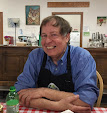There's no place like home
I wonder if we have made a big mistake in thinking of school as being like a
workplace. What if we thought of school as being like home instead.
I can just imagine what you may be thinking at this point: Gee, Tom, I already spend enough time at school as it is. I don't want to start thinking
of it as my home, too.
But before you close this window, please read a little further.
I'm not suggesting that we live at school. Rather, I'm suggesting that we base our model for learning more on the way learning takes place for little kids at home. Such learning is often more spontaneous, more self-directed, more creative and more arts-centered. That's quite different than the learning model most of us have experienced in college or in high school.
So what if we based teaching and learning on this model of "home." I think it would change the way we see education. I'd like to suggest six concepts which flow from such a change in perspective:
1. Break down all the walls you can.
Learning at school takes place both formally and informally, just as at home. It can take place not only in the classroom, but also in the hall, and even outside the building. It can take place not only during class, but also in the minutes before, the minutes after, and even during breaks. But to take advantage of these opportunities, I think we have to break down our idea that learning takes place only during the actual moments when a class is in session.
2. Build and clean "house" together
Part of living in a home is taking care of the place together. Let's take the same idea into the classroom. Let's allow classes to literally take over the room, making it like "home." This could include decorating the walls and windows and filling the bulletin boards. It could also include making murals and growing flowers. It could also include better efforts at picking up after ourselves, including recycling.
3. Put a theme into the weeks
When you're little and at home, you're very conscious of the weather. Decisions about where and how you play are very dependent on the weather. But as we get older and go to school, we become less and less connected from the world around us. By the time we get to college, the months and the seasons are seldom acknowledged. One way to restore a connection would be to tie classes more to the season of the year. We can look for higher education equivalents of building snow people and jumping in leaves. Another idea would be to note events which occurred on the same day or during the same week as the day of class. I tried that idea last year, introducing each class with a segment called "This week in social policy." It focused on key social policy events which had occurred that week in US history. Examples from one week included US Senate approval of Social Security (1935) and the US Supreme Court Miranda decision (1966).
4. Celebrate student work
There is so much wonderful work which is part of classes. But all too often only the teacher gets to see it. I'd like to see more student research presented, more student writing published, and more student posters on display beyond the specific class. Think of this as a vastly expanded version of putting one's work on the refrigerator at home.
5. Arts builds community
Social work's founders, starting with Jane Addams, were big on theater and other arts as ways to communicate, ways to motivate, and ways to inspire. Several years ago, I suggested we create a play based on "our own story" here in North Hall. "Start with Bill Sackter, mix in the history of this building, season with stories from social work," I wrote. That idea became "Good Evening from Bill's Coffeeshop." Why not set a goal to do something like this every semester in every class. Think of it as the grown-up equivalent of inviting adults to see the fort you built in the backyard or the playhouse under the dining room table.
6. Feed me, I'm yours
Sooner or later in class you'll want a snack. There are some classes which have been doing this on a regular basis; there are others where it has happened spontaneously. How about building this into the plan for a course. Snacks help build a sense of community, snacks make you feel, well, -- "at home." And what could be better than that.(Incidentally, "Feed me, I'm yours" is the title of a book of easy snacks parents can make at home with their children.)
Now it's your turn. What do you think? Perhaps you have your own ideas for reshaping our concepts of teaching and learning. Perhaps you have a better image than "home" to make this work. I'd love to hear from you.

